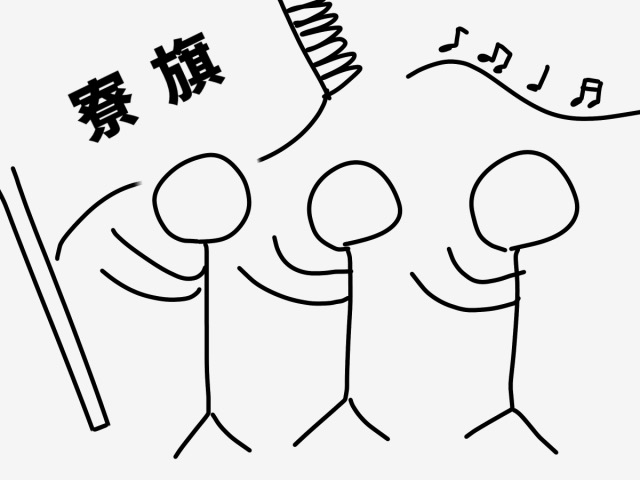
Firsthand account reveals it’s not all pillow fights and gossip sessions.
Like many countries around the world, students in Japan have the option to live in a dormitory while studying at university. That was the case for our reporter Saya Togashi, who lived in a women’s dormitory when she was at uni, and according to her, it wasn’t an idyllic setup where young women exchanged clothes and love stories. It was a tough time for her, as it is for many students who may not be suited to communal living arrangements, so she’d like to pull the curtain back and share with us what it was really like to live there.
▼ For starters, it wasn’t like this.
Saya says it was a couple of decades ago when she lived at the dorm, but given that the traditions and rules had already been in place for years before she was there, she doubts whether a lot would have changed in the years since. Of course, dormitories may differ depending on the setup, but Saya belonged to a “self-governing dormitory“, where the management was entrusted to the hands of the students, with no external supervision from an adult such as a dormitory superintendent or manager. At the time, the legal age of adulthood was 20, and although it’s since been lowered to 18, the idea of truly becoming an adult at age 20 is still prevalent in society, due to the annual nationwide Seijin no Hi (Coming of Age Day) public holiday, where those who turn 20 take part in special seijinshiki celebrations.
In a self-governing dormitory, the student representatives form a self-governing association, and they also clean the house themselves. Only meals were prepared by external cooks in the form of a consignment arrangement by the residents’ association.
The living room was a four-person room with bunk beds, and it was designed to mix grades as much as possible. The dormitory fee was about 25,000 yen (US$171.78) a month, which was surprisingly cheap, even by standards of the time.
▼ Saya’s room in the dorm.
The dormitory had a long history dating back to the Showa period (1926-1989), and the building was so old that stories of ghosts were commonly told. However, it’s the many traditions, passed down from generation to generation, that stay with Saya to this day.
The first of these traditions was what she calls “Learning Stunts“. The acquisition of these “stunts” was the first obstacle that new students had to overcome, and though they might consist of short plays and recreational activities, similar to what you’d find in a Boy Scout’s organisation, in Saya’s dormitory, they were dances.
New students had to learn the dormitory song that had been passed down in the dormitory for generations and the choreography for dancing to the music. Then they would perform these dances in large groups at seasonal events.
For a while after entering the school, Saya often had to rush back to the dormitory and practice the dance straight after her lectures. Even those who might prefer to go off to their part-time jobs or club activities had to participate in dance practice.
▼ No time for anything but dance.
Following the examples of the “senpai”, or senior students, Saya practiced the dance day after day, and she and her fellow students were desperate to learn the steps because practice would never end until they’d memorised the choreography.
Looking back on it now, Saya believes the purpose of these stunts is probably to strengthen the bond between new students and help them to become friends, and it seems that some youth hostels and rider houses (super budget dorms in Japan) still have similar customs.
Once they’d learnt the steps, Saya and her fellow dorm residents were required to perform at numerous events, so a lot of time was spent on planning additional things like singing, drama, and one-shot performances. Though at the time Saya didn’t think the whole dance thing was worth anything, she can see the benefit it might have in training students to work together in teams when they enter the corporate world, and it might come in handy for any performances they might face at company bonenkai (year-end parties).
▼ Saya dutifully dancing with the other dorm residents.
One of the most surprising things Saya came across was the bathing etiquette at the dorm. The dormitory had a large public bath, and it was supposed to be used within a set time. When entering the large public bath, new students were required to speak loudly, almost like a cheerleader, towards the people already in the bathing area. Both parties would be naked at the time, of course.
Saya remembers having to open the glass door of the bathing area and announce who she was and where she was from, shouting, “I’m from xxx high school in xxx Prefecture! I’m a first-year undergraduate! Saya Togashi is entering!!” This procedure was known as “Storm”, and its roots appear to stem from student activities during the old high school days of yore.
▼ People in the bath would reply “Yo-o!” or “Yo-shi!” (“okay” or “good”) and only after receiving this answer were students then allowed to enter the bathing area.
Both “Stunts” and “Storm” were remnants from a time when university life was seen as a social and ideological collective. Sharing patterns of behaviour like this were said to increase unity and solidarity amongst students.
However, it was a big culture shock for Saya. This was neither an employee dormitory nor a sports team dormitory, and even though they all went to the same university, there were thousands of students, so in the grand scheme of things the only thing the dorm residents had in common was that they lived in the same house. She didn’t feel that these patterns of behaviour would unite all the students, so much as make other students feel as if the dormitory women were in a separate group to them.
▼ Now we move on to another practice in solidarity with Compulsory Joint Parties.
There were many events in the dormitory and everyone was expected to participate so there was no option to be absent. Just some of the parties Saya remembers are the “welcome party for new students,” the “year-end party,” and the “farewell party”, which were held jointly every year with the nearby men’s dormitory.
For Saya, these parties all took place in an era when students weren’t really using mobile phones so the only way to get in touch with anyone you were interested in was to call the dormitory. There was a “telephone room” in the dormitory, and students took turns answering the phone. When a call would come in from the outside, a hall announcement would be made, so everyone could hear who was calling and how many times they’d called.
▼ No sliding into the DMs back in those days.
After the welcome party for new students, there would commonly be a “phone rush”, with announcements being made left right and centre. This would make it clear as to which women in the dorm were being constantly called, and Saya would overhear senior students discussing it, saying things like, “I see xxx is number one this year”, which turned it into some sort of popularity contest. As time went on, word of who ended up in a relationship after these parties would spread at the speed of light through the senior student network.
Saya’s least fond memory of dorm life, however, came at the end, after she moved out of the dormitory.
Though she could understand that the rostered household chores such as cleaning duty, newspaper duty, and telephone duty, made sense, and some of the stricter rules, such as the ones at the cafeteria, where they were limited to one bowl of rice and weren’t allowed any refills, were designed for the good of the group, she just couldn’t get used to the rather rigid environment at the dorm, no matter how hard she tried.
At first, she thought she might have to quit university altogether, but in the end, she decided to move out of the dorm before finishing her degree. In order to move out early, she had to submit a letter of apology with an explanation, and then she was able to leave the dormitory.
While she was glad to have moved out, Saya later heard through the grapevine that after she left, her handwritten apology was posted for a while in the toilet used by all the dormitory students.
Though Saya’s time at the dorm was less than idyllic, her seniors were very proud of the traditions of the dormitory, and she says there was no violence or abusive language while she was there. It was clear that none of the rules were meant to be spiteful or to throw juniors under the bus, so to speak, but to promote unity and preserve tradition.
The majority of students became used to this type of environment, made lifelong friends, and stayed there until graduation. Saya believes she just didn’t have the right mentality for that type of lifestyle.
Saya also heard that these days, the dormitory rooms are now private rather than shared, and even have their own kitchen and coin-operated shower, and the communal dining room doesn’t exist anymore. She thinks this would make living there easier now, although she still wouldn’t be able to stand all those longstanding traditions.
Featured image: Pakutaso
Insert images © SoraNews24, Pakutaso (1, 2, 3)
● Want to hear about SoraNews24’s latest articles as soon as they’re published? Follow us on Facebook and Twitter!
[ Read in Japanese ]









 Is there any point to holding your chopsticks the “correct” way? Let’s find out【Experiment】
Is there any point to holding your chopsticks the “correct” way? Let’s find out【Experiment】 Temple camping in Japan at Wakayama’s Daitaiji【Photos】
Temple camping in Japan at Wakayama’s Daitaiji【Photos】 Can even our brown thumbs keep this “moss bonsai” kit alive?【Photos】
Can even our brown thumbs keep this “moss bonsai” kit alive?【Photos】 Resident Evil Umbrella green, red herb bath salts now exist in real world, are terrifying【Pics】
Resident Evil Umbrella green, red herb bath salts now exist in real world, are terrifying【Pics】 Shiraishi Island needs YOUR character ideas!
Shiraishi Island needs YOUR character ideas! Should you add tartar sauce to Japanese curry rice? CoCo Ichi makes diners an unusual offer
Should you add tartar sauce to Japanese curry rice? CoCo Ichi makes diners an unusual offer Seaside scenery, history, and so many desserts on Yokohama’s Akai Kutsu【Japan Loop Buses】
Seaside scenery, history, and so many desserts on Yokohama’s Akai Kutsu【Japan Loop Buses】 Japanese city loses residents’ personal data, which was on paper being transported on a windy day
Japanese city loses residents’ personal data, which was on paper being transported on a windy day Foreigner’s request for help in Tokyo makes us sad for the state of society
Foreigner’s request for help in Tokyo makes us sad for the state of society Red light district sushi restaurant in Tokyo shows us just how wrong we were about it
Red light district sushi restaurant in Tokyo shows us just how wrong we were about it Celebrate another year of life by putting it in jeopardy with this birthday candle flower
Celebrate another year of life by putting it in jeopardy with this birthday candle flower Anti-NHK activist recommends “magic words” that will drive away fee collectors instantly
Anti-NHK activist recommends “magic words” that will drive away fee collectors instantly Century-old Hiroshima brewery in one of Japan’s three great sake-brewing spots offers tours in English
Century-old Hiroshima brewery in one of Japan’s three great sake-brewing spots offers tours in English How do European Cup Noodles taste to a Japanese palate?
How do European Cup Noodles taste to a Japanese palate? Akihabara pop-up shop sells goods made by Japanese prison inmates
Akihabara pop-up shop sells goods made by Japanese prison inmates McDonald’s new Happy Meals offer up cute and practical Sanrio lifestyle goods
McDonald’s new Happy Meals offer up cute and practical Sanrio lifestyle goods Japanese ramen restaurants under pressure from new yen banknotes
Japanese ramen restaurants under pressure from new yen banknotes French Fries Bread in Tokyo’s Shibuya becomes a hit on social media
French Fries Bread in Tokyo’s Shibuya becomes a hit on social media Studio Ghibli releases new action figures featuring Nausicaä of the Valley of the Wind characters
Studio Ghibli releases new action figures featuring Nausicaä of the Valley of the Wind characters New private rooms on Tokaido Shinkansen change the way we travel from Tokyo to Kyoto
New private rooms on Tokaido Shinkansen change the way we travel from Tokyo to Kyoto Tokyo Tsukiji fish market site to be redeveloped with 50,000-seat stadium, hotel, shopping center
Tokyo Tsukiji fish market site to be redeveloped with 50,000-seat stadium, hotel, shopping center Beautiful Ghibli sealing wax kits let you create accessories and elegant letter decorations【Pics】
Beautiful Ghibli sealing wax kits let you create accessories and elegant letter decorations【Pics】 Studio Ghibli releases Kiki’s Delivery Service chocolate cake pouches in Japan
Studio Ghibli releases Kiki’s Delivery Service chocolate cake pouches in Japan New definition of “Japanese whiskey” goes into effect to prevent fakes from fooling overseas buyers
New definition of “Japanese whiskey” goes into effect to prevent fakes from fooling overseas buyers Our Japanese reporter visits Costco in the U.S., finds super American and very Japanese things
Our Japanese reporter visits Costco in the U.S., finds super American and very Japanese things All-you-can-drink Starbucks and amazing views part of Tokyo’s new 170 meter-high sky lounge
All-you-can-drink Starbucks and amazing views part of Tokyo’s new 170 meter-high sky lounge More foreign tourists than ever before in history visited Japan last month
More foreign tourists than ever before in history visited Japan last month New Pokémon cakes let you eat your way through Pikachu and all the Eevee evolutions
New Pokémon cakes let you eat your way through Pikachu and all the Eevee evolutions Disney princesses get official manga makeovers for Manga Princess Cafe opening in Tokyo
Disney princesses get official manga makeovers for Manga Princess Cafe opening in Tokyo Sales of Japan’s most convenient train ticket/shopping payment cards suspended indefinitely
Sales of Japan’s most convenient train ticket/shopping payment cards suspended indefinitely Sold-out Studio Ghibli desktop humidifiers are back so Totoro can help you through the dry season
Sold-out Studio Ghibli desktop humidifiers are back so Totoro can help you through the dry season Japanese government to make first change to romanization spelling rules since the 1950s
Japanese government to make first change to romanization spelling rules since the 1950s Ghibli founders Toshio Suzuki and Hayao Miyazaki contribute to Japanese whisky Totoro label design
Ghibli founders Toshio Suzuki and Hayao Miyazaki contribute to Japanese whisky Totoro label design Doraemon found buried at sea as scene from 1993 anime becomes real life【Photos】
Doraemon found buried at sea as scene from 1993 anime becomes real life【Photos】 Tokyo’s most famous Starbucks is closed
Tokyo’s most famous Starbucks is closed One Piece characters’ nationalities revealed, but fans have mixed opinions
One Piece characters’ nationalities revealed, but fans have mixed opinions We asked a Uniqlo employee what four things we should buy and their suggestions didn’t disappoint
We asked a Uniqlo employee what four things we should buy and their suggestions didn’t disappoint Princesses, fruits, and blacksmiths: Study reveals the 30 most unusual family names in Japan
Princesses, fruits, and blacksmiths: Study reveals the 30 most unusual family names in Japan The Mountain Has Moved capsule toys literally move mountains for your enjoyment
The Mountain Has Moved capsule toys literally move mountains for your enjoyment We tried cooking with a personal fryer and now we’re obsessed
We tried cooking with a personal fryer and now we’re obsessed This USB device exists solely to warm up rice balls, and honestly, it does a great job
This USB device exists solely to warm up rice balls, and honestly, it does a great job How Japanese universities are trying to help worried parents by babying their students
How Japanese universities are trying to help worried parents by babying their students We tried making natto the old-fashioned way, and the result was unexpected but delicious 【SoraKitchen】
We tried making natto the old-fashioned way, and the result was unexpected but delicious 【SoraKitchen】 How to cancel a floor on a Japanese elevator
How to cancel a floor on a Japanese elevator YouTube goes crazy for “Bubbly” high school girls’ amazing retro ’80s dance routine 【Video】
YouTube goes crazy for “Bubbly” high school girls’ amazing retro ’80s dance routine 【Video】 We spice up our fermented soybeans with curry powder flavored natto【Taste Test】
We spice up our fermented soybeans with curry powder flavored natto【Taste Test】 Japan’s amazingly realistic CG schoolgirl learns how to kiss 【Video】
Japan’s amazingly realistic CG schoolgirl learns how to kiss 【Video】 There’s no reason not to play with your food with this natto in Nanoblock form
There’s no reason not to play with your food with this natto in Nanoblock form The best-selling rice ball at Family Mart is…SPAM onigiri?
The best-selling rice ball at Family Mart is…SPAM onigiri? In the search for the perfect crunchy cream puff, we try Beard Papa’s new cookie-topped choux
In the search for the perfect crunchy cream puff, we try Beard Papa’s new cookie-topped choux ‘Butter mochi’ flavoured chocolate may be the best kind of Tirol we’ve ever tasted
‘Butter mochi’ flavoured chocolate may be the best kind of Tirol we’ve ever tasted Traditional Japanese cuisine gets an out of this world treatment — we try Japanese Space Food
Traditional Japanese cuisine gets an out of this world treatment — we try Japanese Space Food Our matcha skeptic finds green tea dessert for people who don’t like green tea sweets【Taste test】
Our matcha skeptic finds green tea dessert for people who don’t like green tea sweets【Taste test】
Leave a Reply